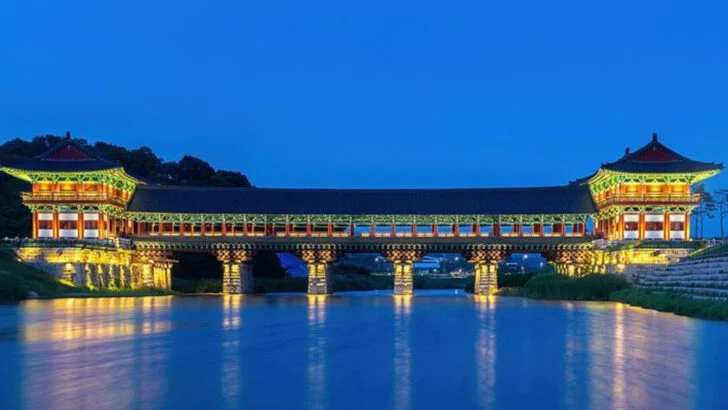South Korea has become one of the world’s most talked-about travel destinations, and it’s easy to see why. From ancient palaces and quiet temples to dynamic cities like Seoul and Busan, the country offers a balance of deep tradition and cutting-edge modernity. Every corner feels like a chance to explore both history and the future at once.
What draws travelers most, though, is the way South Korea blends its cultural identity into daily life. Whether through street food that feels like a celebration, vibrant K-pop and fashion scenes, or breathtaking mountain landscapes and coastal views, the experience is both rich and unforgettable.
Seoul’s Mix of Palaces, Shopping, and Nightlife
Seoul is a city where ancient history and modern life seamlessly blend. Marvel at the majesty of Gyeongbokgung Palace, a stunning reminder of Korea’s royal past.
The shopping districts like Myeongdong never sleep, offering everything from high fashion to quirky souvenirs. As the sun sets, the city transforms into a nightlife paradise.
With bustling street markets and lively bars, Seoul offers a dynamic experience that keeps visitors coming back for more.
Busan’s Beaches and Seafood Culture
Busan, South Korea’s second-largest city, is famed for its stunning beaches like Haeundae and Gwangalli. Perfect for sunbathers and surfers alike, these coastal gems offer breathtaking views and lively atmospheres.
Seafood lovers will be in heaven at Jagalchi Fish Market, where the freshest catches are served up daily.
From the salty sea air to the vibrant food scene, Busan offers a feast for the senses.
Gyeongju’s Historic Temples and Tombs
Known as the “museum without walls,” Gyeongju is a treasure trove of historical sites. Bulguksa Temple and Seokguram Grotto, both UNESCO World Heritage Sites, showcase the intricate beauty of Silla-era architecture.
Explore the ancient tombs scattered across the city, each telling stories from Korea’s past.
Gyeongju offers a serene escape into the country’s rich cultural heritage, perfect for history enthusiasts.
Jeju Island’s Natural Wonders
Jeju Island, often called “Korea’s Hawaii,” captivates with its volcanic landscapes and stunning natural beauty. Hallasan Mountain towers majestically, offering hiking trails with panoramic views.
Waterfalls like Cheonjiyeon add to the island’s charm, while the unique lava tubes intrigue explorers.
With a mild climate and diverse ecosystems, Jeju is a natural wonderland waiting to be discovered.
Korean Street Food Culture
The streets of South Korea are a food lover’s paradise, bustling with vibrant stalls and irresistible aromas. Tteokbokki, spicy rice cakes, is a must-try delight, while hotteok, sweet pancakes, offer a comforting treat.
Kimbap, Korean-style sushi rolls, make for a perfect on-the-go snack.
Street food markets provide a sensory experience, showcasing the flavors of Korea in their most authentic form.
K-pop and Entertainment Influence
K-pop has taken the world by storm, making South Korea a hub for entertainment enthusiasts. Seoul’s vibrant music scene offers concerts featuring top idols and emerging artists alike.
Entertainment districts like Hongdae and Gangnam are filled with live music venues and dance clubs.
The global influence of K-pop is undeniable, drawing fans from all corners of the globe.
Traditional Hanok Villages
Step back in time as you wander through South Korea’s hanok villages. Bukchon Hanok Village, nestled in the heart of Seoul, boasts beautifully preserved traditional houses with elegant tiled roofs.
These villages offer a glimpse into Korea’s architectural past, with their serene courtyards and wooden structures.
They provide a peaceful retreat from the bustling city, allowing visitors to experience the charm of a bygone era.
Hiking in the Mountains
With its sprawling landscapes, South Korea is a paradise for hiking enthusiasts. The Seoraksan National Park offers trails that wind through striking rock formations and lush forests. Each season paints the scenery with its own unique palette.
Whether you’re challenging yourself with a peak climb or enjoying a leisurely walk, the mountains here promise rejuvenation for both body and soul.
Avid hikers and casual walkers alike can find their perfect path among these majestic terrains.
Cutting-Edge Technology and Design
Home to global tech giants, South Korea is at the forefront of innovation. In cities like Seoul, smart technology seamlessly integrates with daily life. From AI-powered cafes to high-speed internet, the future feels tangible here.
Design enthusiasts can explore avant-garde architecture and sleek urban spaces, showcasing the nation’s creative pulse.
Visitors are often amazed at how technology enhances convenience and connectivity, making everyday experiences extraordinary.
Seasonal Festivals and Markets
Korean festivals burst with color and excitement, offering a true taste of local culture. The Lantern Festival, for example, lights up the night with shimmering displays.
Markets brim with handcrafted goods and traditional foods, providing a sensory feast. Each season brings its own celebration, drawing locals and visitors alike into the festivities.
These gatherings are not just events; they’re immersive experiences that showcase the heart of Korean culture.

